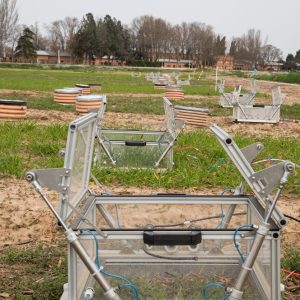Our group consists of 3 lecturers. 4 permanent professors, 3 doctorates under contract, 1 assistant doctorate, 2 post-graduate researchers (CM and JdC) and 2 undergraduates. There are also two laboratory technicians and a project manager with extensive post-graduate training. The group as a whole has published a total of 77 SCI, more than 85% of which were in Q1. It is a part of the UPM research centre CEIGRAM .
Site card
Contamination of agroecosystems caused by agricultural practices
COAPA
Structure: Research Groups
Email: Infrastructures:
During 1990-2000, the group focussed its work on nitrate leaching caused by agricultural practices and assessing the balance of nitrogen. Since 2000, the group has broadened it line towards the "Assessment of greenhouse gas emissions on soil", which is an important part of the group's work and has brought it significant recognition internationally. Our articles have been used as a basis for making progress with strategies to mitigate nitrogen oxide and ammonia emissions into farmland.
During the last 20 years, without interruption, the group's main researcher has been running national plan projects (for agriculture) specifically along this line. We have also taken part in various European consortia and entered into many contracts with companies in the fertiliser sector (such as Fertiberia, Agrotain, K + S Plus Iberia, Koch Agronomic Services and EuroChem Agro Iberica) which have played an important role in funding the research. Some members of the group keep the micro-nutrients with zinc line active, and have published many articles about it.
- Agricultural use of organic waste
- Contamination of aquifers by nitrates
- Greenhouse gas emissions from soil
- Metals in Agroecosystems
- Volatilization of ammonia in agricultural soil
A strong point of the group is its capacity for carrying out research in field conditions, which are a good replica of agricultural reality. To do this, we collaborate with the National Irrigation Technology Centre (CENTER), which belongs to the Ministry of Agriculture, Fisheries and Food, and the Madrid Institute for Rural, Agricultural and Food Research and Development (IMIDRA), which has experimental farms for carrying out studies under conditions that are similar to a real agricultural business. Another strong point is the group's high level of internationalisation, as shown by the large number of articles written in collaboration with important researchers from other international centres.
The technical specifications, along with the research programme web site AGRISOST, includes a detailed summary of the group's publications and projects.
Showing the single result
-
Technology that enables polluting emissions from agricultural systems to be reduced based on handling nitrogen fertiliser and irrigation, the use of nitrification and urease inhibitors,…





